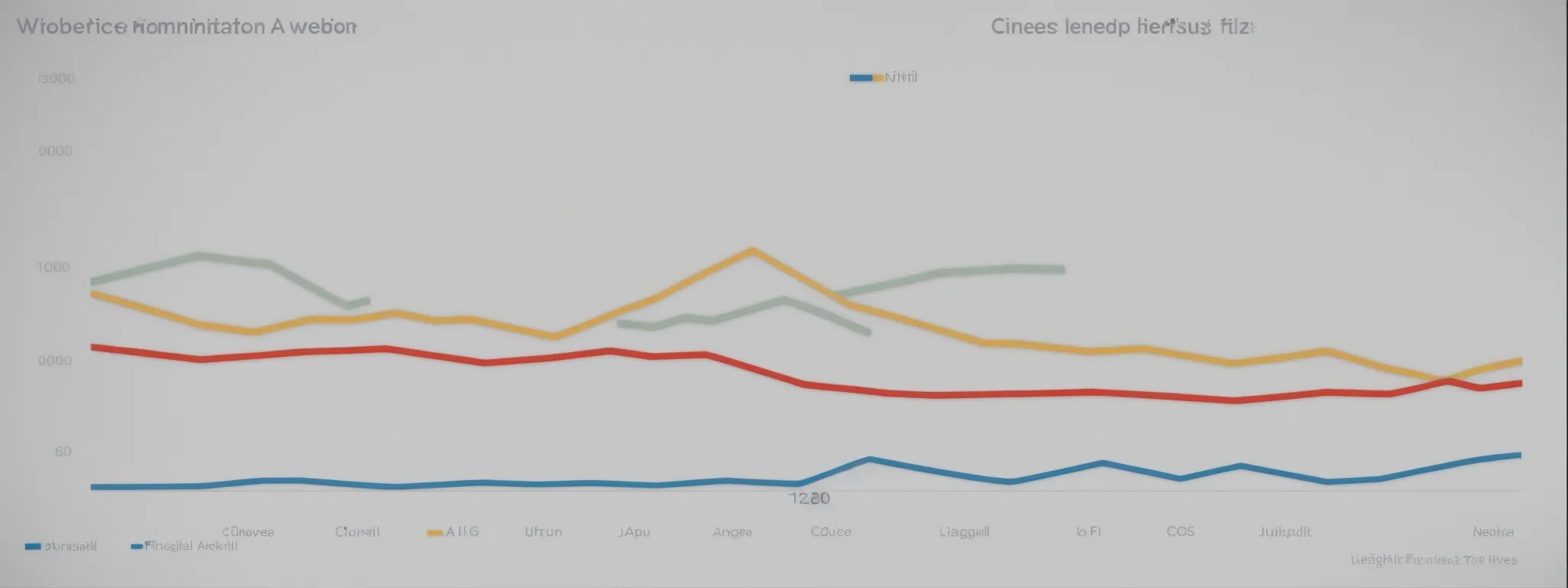Page Size SEO
Optimizing Your SEO With the Right Page Size: Balancing Speed and Content In an era where online presence is tied closely to a company’s success, optimal page […]
Optimizing Your SEO With the Right Page Size: Balancing Speed and Content
In an era where online presence is tied closely to a company’s success, optimal page size emerges as a pivotal element in search engine optimization.
A fine-tuned balance is required; one must navigate the dichotomy of enriching a website with valuable content while ensuring rapid page load times to enhance user experience and SEO rankings.
Techniques to compress and optimize page elements can drastically improve a site’s performance, thus LinkGraph’s SEO services focus on refining this harmony to bolster online visibility.
By addressing the heft of HTML files, optimizing image sizes, and implementing effective caching strategies, businesses can foster a seamless digital environment conducive to both client satisfaction and search engine approval.
Continue exploring how our expertise in optimizing page size can significantly boost your SEO endeavors.
Key Takeaways
- Optimal Page Size Enhances User Experience and Search Rankings
- Advanced Optimization Techniques Like Image Compression and Code Minification Improve Page Load Times
- Regular Monitoring and Refinement of Page Size Metrics Are Critical for Effective SEO
- Employing CDNs and Lazy Loading Techniques Can Significantly Boost Site Performance
- Mobile Optimization, Including Responsive Design and AMP Integration, Is Key for Modern SEO Strategies
Understanding Ideal Page Size for SEO Efficiency

In the quest for dominance in search engine results, understanding the balance between comprehensive content and optimal website performance is vital.
As the digital industry evolves, the pillars supporting search engine optimization (SEO) shift, compelling digital marketers and SEO specialists to analyze every facet of website design for competitive advantage.
Among the critical elements under scrutiny is the concept of proper page size, which carries significant weight in both user experience and search rankings.
This introductory discussion will pivot towards defining the optimal range for webpage size and exploring its tangible impact on search engine visibility, setting the stage for a deeper investigation into the mechanics of balancing rich content with agile, swift-loading pages.
Defining Optimal Page Size Range
When discussing page size, experts in the field of SEO commonly refer to the total file size of a webpage, which includes the HTML document, cascading style sheets (CSS), JavaScript files, and multimedia content. A lighter page often loads faster, leading to a smoother user experience and potentially better search engine rankings, whereas a heavier page may suffer from increased load times and user frustration.
The challenge lies in establishing an optimal range for page size that effectively caters to SEO principles without compromising on the richness of the content. Ideal page measurements vary, but current trends suggest keeping the total size under 3 megabytes to ensure a page remains nimble enough for both desktop and mobile browsers:
- Strike a balance between multimedia elements and text.
- Implement image optimization techniques to reduce file size without diminishing quality.
- Utilize compression and minification for HTML, CSS, and JavaScript files to lighten the page load.
Impact of Page Size on Search Rankings
The correlation between page size and search rankings is an intricate aspect of SEO that LinkGraph’s SEO services scrutinize meticulously. A page swamped with excess data may lag behind in load speed, signaling search engines that the page may not provide the swift experience today’s internet users expect. Given that search engines, notably Google, prioritize page experience, LinkGraph’s SEO services underscore the significance of optimizing page weight to enhance rankings.
LinkGraph’s on-page SEO services recognize that a finely tuned page size not only benefits rankings but also user retention, a factor not lost on search algorithms. By curating content with precise coding and streamlined media files, LinkGraph’s SearchAtlas SEO software enables web pages to load with remarkable efficiency, thus maintaining the delicate balance between rich content and performance that underpins SEO success.
The Balance Between Rich Content and Page Load Speed

In the intricate dance of search engine optimization, webmasters find themselves at the crossroads of providing valuable content and ensuring nimble page load speeds.
As the digital landscape grows increasingly competitive, the imperative to deliver information swiftly while ensuring the quality remains undiluted has never been greater.
LinkGraph’s SEO services deftly navigate this terrain, optimizing sites to feature content that resonates with readers and adheres to the standards of modern search engines – a testament to the harmonious union of substance and speed.
Prioritizing Content That Adds Value
Efficiency in SEO extends beyond just technical optimization; it requires a strategic focus on creating content that offers genuine value to readers. LinkGraph’s SEO services emphasize the importance of quality over quantity, ensuring that every piece of content, whether it’s text, images, or multimedia, serves a purpose and enriches the user’s experience.
Assisting clients in identifying and producing content that resonates with their audience, LinkGraph’s SEO services harness insights to foster engagement and drive conversions. Content must align with consumer needs and intent, reinforcing the brand’s authority and trustworthiness in its respective industry:
- Identifying key topics and questions that preoccupy the target audience.
- Developing insightful, well-researched, and original content that addresses those areas.
- Measuring the impact of content through analytics and adjusting strategies accordingly.
Employing Content That Loads Faster
LinkGraph’s SEO services offer a blend of technological prowess and creative insight that ensures content is not only impactful but also performance-optimized. Employing advanced techniques like image compression, leveraging browser caching, and code minification, these services aim to hasten the page load times, a vital element for sustaining user engagement and satisfying the speed requirements of search engines.
Consumers today demonstrate minimal patience for sluggish websites; this makes swift page load speed a non-negotiable attribute for businesses aiming to cement their online presence. LinkGraph’s SEO services provide their clients with solutions that flawlessly integrate into an overarching SEO strategy, focusing on reducing file sizes from images and scripts to facilitate a more prompt page load, enhancing both user experience and search engine favorability.
| SEO Factor | Best Practices | LinkGraph’s Solutions |
|---|---|---|
| Image Compression | Optimize without losing quality | Advanced compression techniques |
| Browser Caching | Store frequently used data | Efficient caching strategies |
| Code Minification | Remove unnecessary characters | Streamline HTML, CSS, JavaScript |
Techniques to Compress Page Size Without Losing Quality

In the digital marketing milieu, efficiency in web page size is not simply about aesthetic and performance—it’s about the synthesis of speed and substance in the calculus of search ranking algorithms.
As professionals involved in SEO diligently navigate the complexities of website optimization, they encounter essential practices that stand as cornerstones of enhancing page responsiveness without sacrificing the integrity of the content.
Among these practices, image optimization and compression, as well as the minification of CSS, JavaScript, and HTML files, emerge as pivotal techniques.
They are indispensable for condensing digital assets, thus creating leaner, more agile web experiences that align with the standards of search engines and user expectations alike.
Image Optimization and Compression
Grasping the subtleties of image optimization and compression is pivotal in mastering SEO tactics. LinkGraph’s SEO services are adept at applying state-of-the-art compression methodologies to decrease image file sizes, ensuring swift loading times while maintaining visual fidelity which, in return, bolsters SEO rankings and elevates page performance in line with user expectations.
In the optimization process, LinkGraph’s cutting-edge technology scrutinizes each image to discern the optimal balance between quality and file size. This careful calibration eliminates superfluous data without degrading the aesthetic, allowing the website to load expeditiously, thus contributing to a robust SEO framework that enhances both user experience and search engine visibility.
Minification of CSS, JavaScript, and HTML
The technique of minification is essential for refining the backend elements of a website to expedite page loading performance. By removing all unnecessary characters from CSS, JavaScript, and HTML files, LinkGraph’s SEO services streamline the code, contributing to a reduction in HTTP requests and enhancing overall website speed.
Minification is a nuanced optimization method that enables web pages to function with maximal efficiency. LinkGraph’s expert team applies this process to condense code and eliminate redundancy, ensuring a trimmed-down file size that preserves functionality while significantly improving page load times:
- Analyze and identify redundant or unnecessary code within web page files.
- Employ advanced tools to automate the minification process, ensuring accuracy and consistency.
- Continuously monitor and update code to maintain optimal performance as site content evolves.
Identifying Page Elements That Slow Down Your Site

As websites grow more complex, laden with features aimed at enhancing user engagement, they must remain vigilant against the inadvertent sluggishness that can accompany such innovations.
The hidden culprits often reside within the very enhancements believed to enrich the user’s journey—burdensome scripts and an overabundance of plug-ins, or the intrusive heft of advertisement scripts, can all dampen page performance.
As SEO professionals hone their craft, a key focus is the meticulous audit of these elements, to ensure that they do not impede swift navigation or hamper the site’s ability to climb the SEO ranks.
Auditing Hefty Scripts and Plug-Ins
Auditing hefty scripts and plug-ins is a crucial step toward ensuring a website’s performance remains robust. LinkGraph’s SEO services delve into the site’s architecture, scrutinizing the scripts and plug-ins that could be causing unnecessary lag.
By systematically evaluating the impact of each script and plug-in, the process identifies those that are essential for functionality versus those that may be streamlined or removed:
- Examine each script and plug-in for efficiency and necessity.
- Determine the impact on load times and overall performance.
- Take appropriate action to optimize or eliminate performance-hindering elements.
The Cost of Excessive Advertisement Scripts
Excessive advertisement scripts introduce a weighty toll on website performance, deleteriously affecting page load times. The presence of multiple ad scripts can lead to an accumulation of latency, noticeably dragging down the speed at which content becomes accessible to the user, thus potentially skewing bounce rates and undermining SEO efforts.
LinkGraph’s SEO services keenly evaluate the necessity of each ad script, cognizant of their potential to inhibit optimal page function. Through careful curation, they seek to strike a delicate balance: sustaining a revenue stream from ads without conceding the swift page experience that is crucial for maintaining user engagement and search engine rankings:
| Element | Challenge | LinkGraph’s Optimization Approach |
|---|---|---|
| Ad Scripts | Increased load times | Strategic reduction and optimization |
| User Engagement | Bounce rates due to slow pages | Enhancing page load speed |
| SEO Rankings | Negative impact from sluggish load | Maintaining balance between ads and performance |
Streamlining Content Delivery for Improved Page Size

In the arena of Search Engine Optimization, where milliseconds can affect user engagement and rankings, a strategic approach to content delivery is paramount.
LinkGraph’s SEO services recognize that the harmonious delivery of website elements is essential in optimizing page size without undermining content quality.
To this end, strategies like employing Content Delivery Networks (CDN) and incorporating lazy loading for media form the bedrock of an efficient content distribution framework.
Effective utilization of these technologies ensures resources are managed wisely, thus accelerating load times and reinforcing the SEO stature of a client’s digital presence.
Utilizing Content Delivery Networks (CDN)
Content Delivery Networks (CDNs) are at the forefront of enhancing user experience by decreasing the distance between the website’s server and the visitor. Through a network of distributed servers, LinkGraph’s SEO services integrate CDNs to serve content from the closest node, leading to notably faster load times and improved site speed—a critical ranking factor for search engines.
By adopting the utilization of CDNs, LinkGraph’s clients experience a remarkable optimization of their site’s performance across the globe. Such strategic deployment not only boosts page speed but also contributes to reducing server load, a dual advantage that solidifies the website’s SEO foundation and ensures content is delivered with unparalleled efficiency.
Implementing Lazy Loading for Media
Incorporating lazy loading protocols, LinkGraph’s SEO services proactively enhance media management as part of a comprehensive SEO strategy. This technique permits images and videos to only load as they enter the viewport, thereby conserving bandwidth and improving page speed without compromising the visual elements that enrich user experience.
Through the application of lazy loading, LinkGraph helps clients boost overall site performance, particularly on pages with heavy image content. This practice not only elevates page speed but also contributes positively to SEO, as search engines favor websites that present an expedient, user-friendly interface.
How Mobile Optimization Relates to Page Size

In an era of mobile-first indexing, recognizing the pivotal role of mobile optimization in SEO strategy is imperative for digital marketers.
With a majority of online searches now conducted on mobile devices, the necessity for websites to be responsive and considerate of mobile page size cannot be overstated.
This understanding guides the adoption of technologies such as Accelerated Mobile Pages (AMP), which can dramatically impact SEO outcomes.
Moving forward, the conversation will revolve around the integration of responsive design to ensure content is efficiently accessible across various devices and the strategic implementation of AMP to bolster visibility in mobile search results.
Responsive Design and Mobile Page Size Considerations
Embracing responsive design is a strategic imperative for businesses targeting a mobile-savvy audience. LinkGraph’s SEO services ensure that client websites adapt fluidly across various screen sizes, a practice that directly affects mobile page size by delivering an appropriately scaled user experience.
With mobile page size optimization in focus, LinkGraph’s SEO services implement responsive techniques that enhance loading times on handheld devices. This proactive stance on mobile responsiveness solidifies the user experience, positively affecting search engine visibility and user engagement metrics.
| Aspect of Mobile Optimization | Objective | Impact on SEO |
|---|---|---|
| Responsive Design | Fluid adaptation to various screen sizes | Improved user experience and usability |
| Mobile Page Size | Optimized loading times for mobile devices | Enhanced search ranking and engagement |
AMP Pages and Their Effect on SEO
Accelerated Mobile Pages (AMP) serve as a pivotal component in an SEO strategy oriented towards mobile users. By streamlining the design and functionality of web pages, AMP aims to reduce load times significantly on mobile devices, thereby boosting user engagement and SEO ranking potential for these pages.
Recognizing that the AMP framework directly influences the visibility in mobile search results, LinkGraph’s SEO services integrate AMP to enhance the mobile user journey. The optimization for AMP is not merely an adjustment to page size; it is a strategic leap towards higher performance in mobile search ecosystems, ensuring that content is delivered instantaneously and is seamlessly accessible to users on the go.
| Component | Function | SEO Impact |
|---|---|---|
| AMP Framework | Streamline mobile web pages for fast loading | Improved search rankings and user engagement |
| Integration Process | Apply AMP standards to client web pages | Higher performance and accessibility in mobile search |
Case Studies: Page Size Optimization Success Stories

The narrative of digital triumph often revolves around the transformative impact of optimization strategies, particularly in the context of page size reduction and the quest for accelerated load times.
As industry professionals excavate the data-rich landscapes of page size optimization, success stories emerge, illustrating the before and after scenarios of websites that harnessed the potential of targeted SEO enhancements.
These case studies illuminate the real-world benefits, drawing a compelling picture of the tangible improvements in search engine ranking and user engagement catalyzed by meticulous optimization efforts.
Undoubtedly, these narratives set the stage for understanding the critical alliance between swift page performance and enriched content in the ever-evolving quest for SEO eminence.
Before and After: Websites That Improved Their SEO
The transformative tales of web entities that have embraced page size optimization are a testament to the efficacy of sound SEO strategies. A notable instance is a client who, after engaging with LinkGraph’s SEO services, witnessed a marked enhancement in their site’s performance metrics: the consolidation of bulky assets, paired with efficient coding practices, led to a leap in search rankings and a notable reduction in bounce rates.
- Assessment of the website’s initial performance and identification of problematic page elements.
- Execution of advanced optimization techniques, including image compression and code minification.
- Post-optimization performance analysis demonstrating improved SEO outcomes and user experience ratings.
Another success case within LinkGraph’s portfolio showcases a website that struggled with page speed due to unwieldy image sizes. Through a tailored approach utilizing the SearchAtlas SEO software, the site underwent significant image optimization, which resulted in a remarkable 40% increase in page load speed, consequently propelling the website’s positions in SERPs to new heights, while simultaneously bolstering user retention and conversion rates.
Real-World Benefits of Reducing Page Load Time
Slashing page load times is more than a mere technical concern; it can dramatically alter the landscape of user interaction with a web entity. By enhancing page load speed, LinkGraph’s SEO services have observably improved clients’ visitor retention rates, leading to longer session durations and more opportunities for conversions.
Companies leveraging LinkGraph’s adept optimizations experience a direct influence on their bottom line, as faster-loading pages often correlate with an uptick in organic reach and lowered advertising costs. The strategic reduction of page weight ensures a frictionless user experience, fostering a stronger affinity between the brand and its consumer base.
Crafting an SEO Strategy With Page Size in Mind

In the intricate landscape of search engine optimization, a strategic approach to page size is indispensable for achieving optimal online visibility.
As businesses refine their digital presence, an understanding of how page size metrics align with broader SEO objectives becomes critical.
Regularly monitoring these metrics equips decision-makers with actionable insights, allowing for the surgical implementation of content and technical enhancements.
LinkGraph’s SEO services excel in calibrating these elements, orchestrating a synergy between high-quality content and meticulous page optimization to improve site performance and search rankings.
Regular Monitoring of Page Size Metrics
Regular monitoring of page size metrics is a cornerstone of effective SEO, providing businesses with crucial data to assess the impact of content adjustments on site performance. LinkGraph’s SEO services utilize sophisticated tracking tools that allow for constant vigilance over page size changes, enabling proactive optimizations that align with the latest search engine algorithms.
LinkGraph’s dedication to refining search performance extends to the vigilant scrutiny of page size trends, ensuring their strategies remain adaptive to evolving user preferences and technology standards. Their approach allows for the seamless implementation of necessary refinements, keeping clients’ websites at the forefront of page efficiency and search engine results.
Aligning Page Size Goals With SEO Objectives
Aligning page size goals with SEO objectives is not an arbitrary task; it demands an integrated approach where LinkGraph’s SEO services fine-tune the balance between the speed of content delivery and the quality and relevance of the content itself. By setting precise goals for page size, their seasoned experts ensure that the technical optimization works in unison with content strategies to elevate a site’s search engine status.
Within the overarching framework of SEO, the relationship between page size and search rankings is carefully considered by LinkGraph’s professionals. When deploying their expertise, they prioritize the enhancement of site performance, ensuring swift load times and content accessibility without hampering the depth or informativeness that users and search engines value.
Conclusion
Maintaining an optimized page size is crucial for SEO success, striking a balance between speed and content richness.
Insightful strategies like image compression, code minification, and the implementation of CDNs or AMP for mobile lead to swifter loading times without compromising content quality.
Not only do such practices improve user engagement and retention, but they also enhance search rankings, as search engines favor websites that deliver expedient, user-friendly experiences.
Regular monitoring and aligning page size goals with overarching SEO objectives are essential, ensuring technical optimization supports and amplifies the content strategy.
Ultimately, a keen focus on the right page size can significantly elevate a site’s performance, both in the eyes of users and within the competitive SEO landscape.















































































